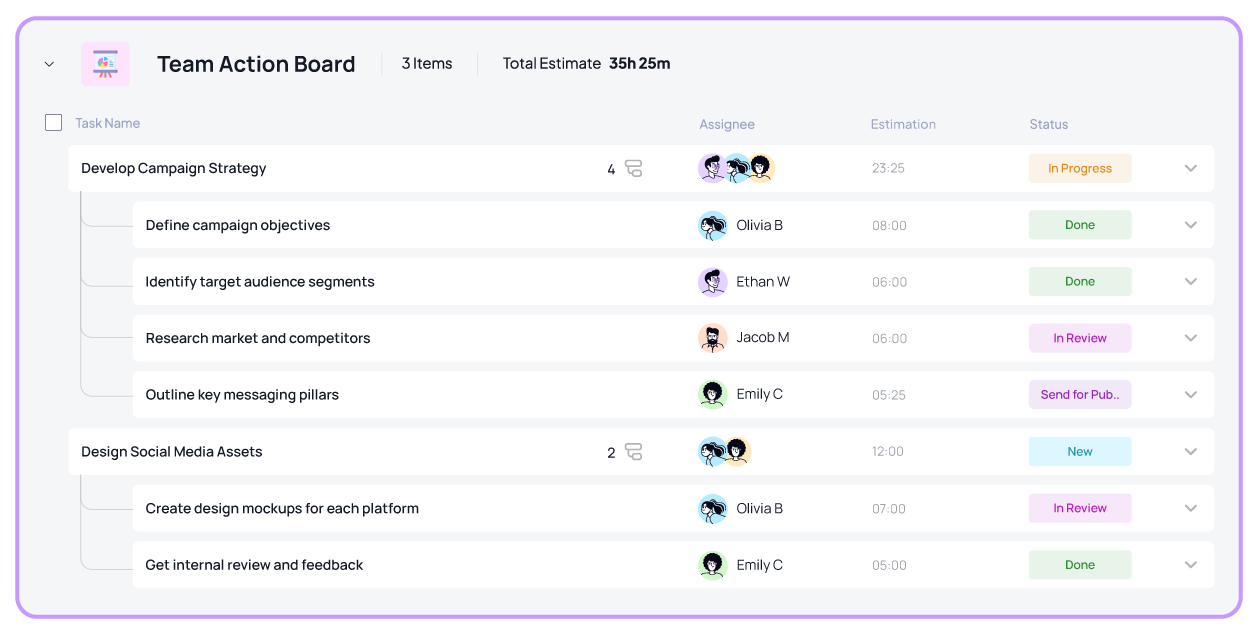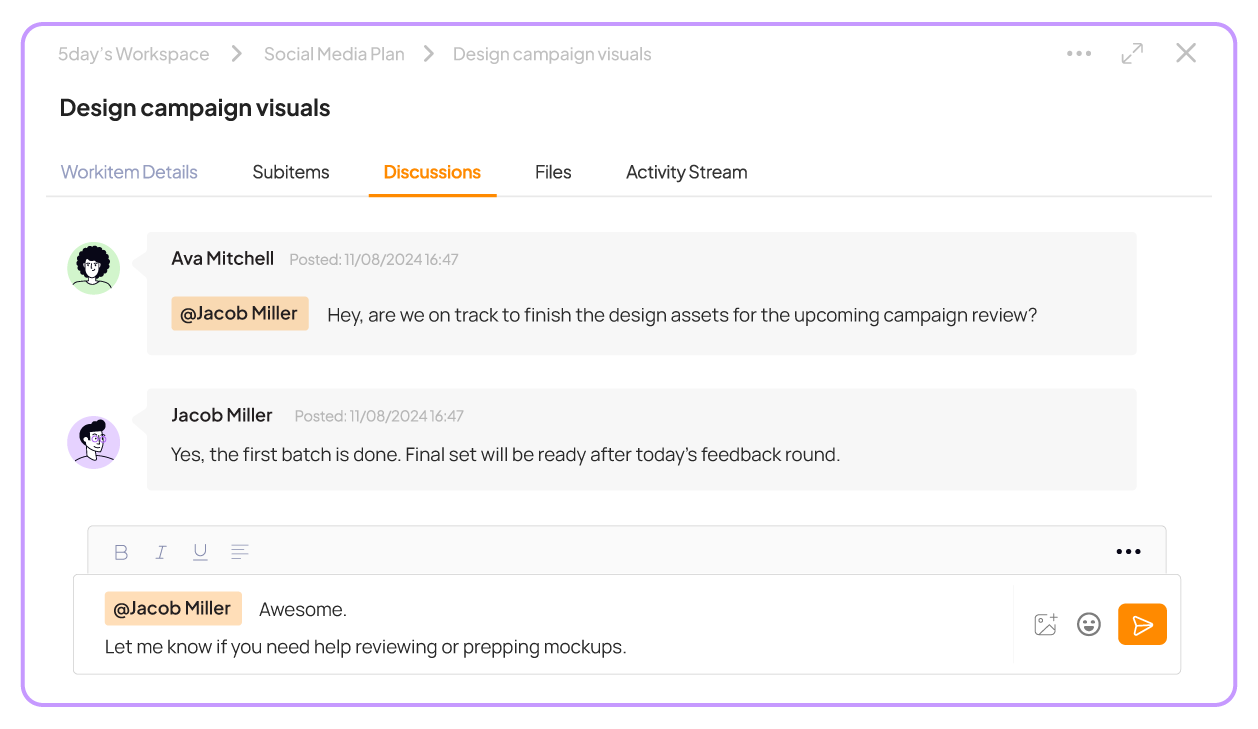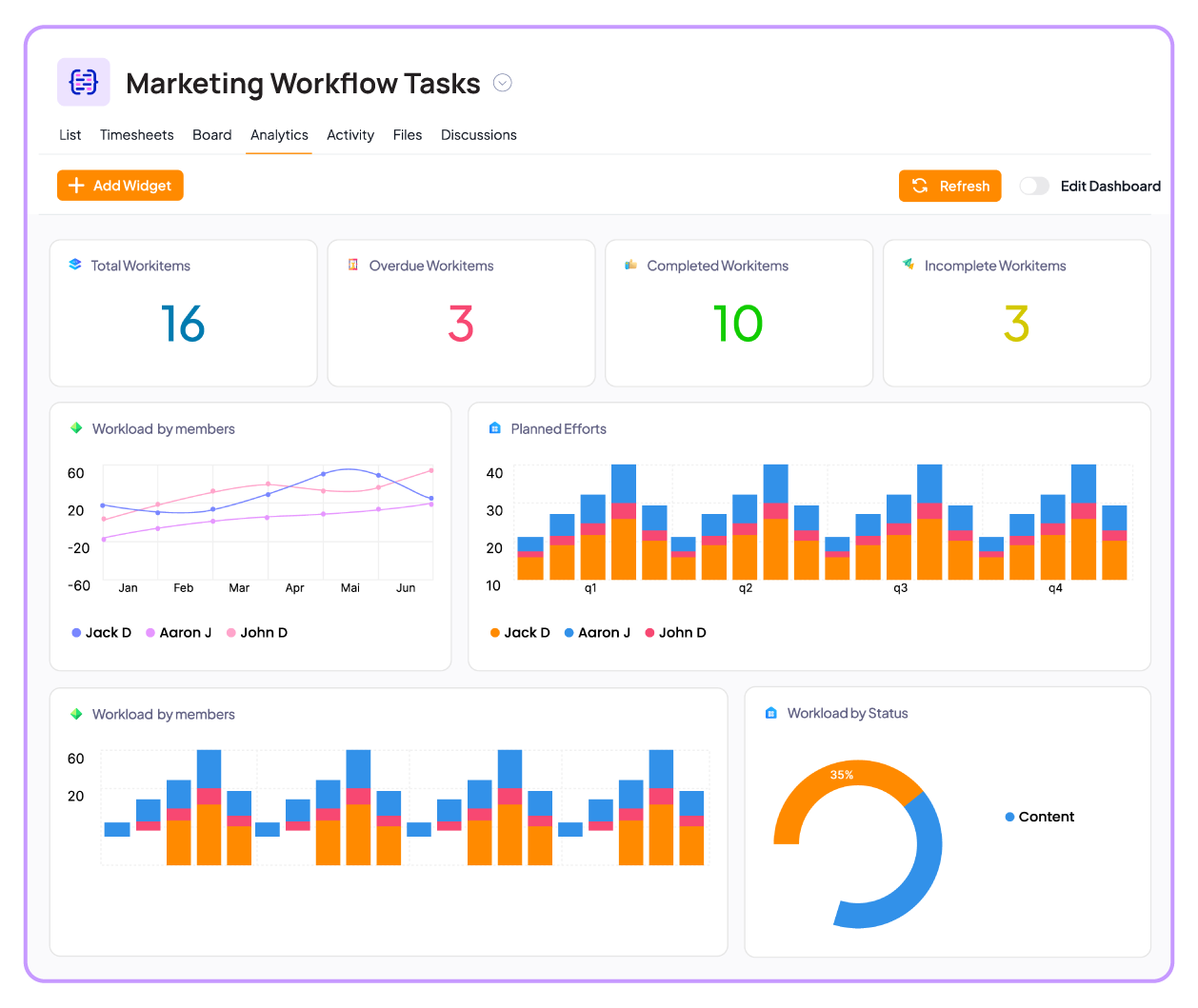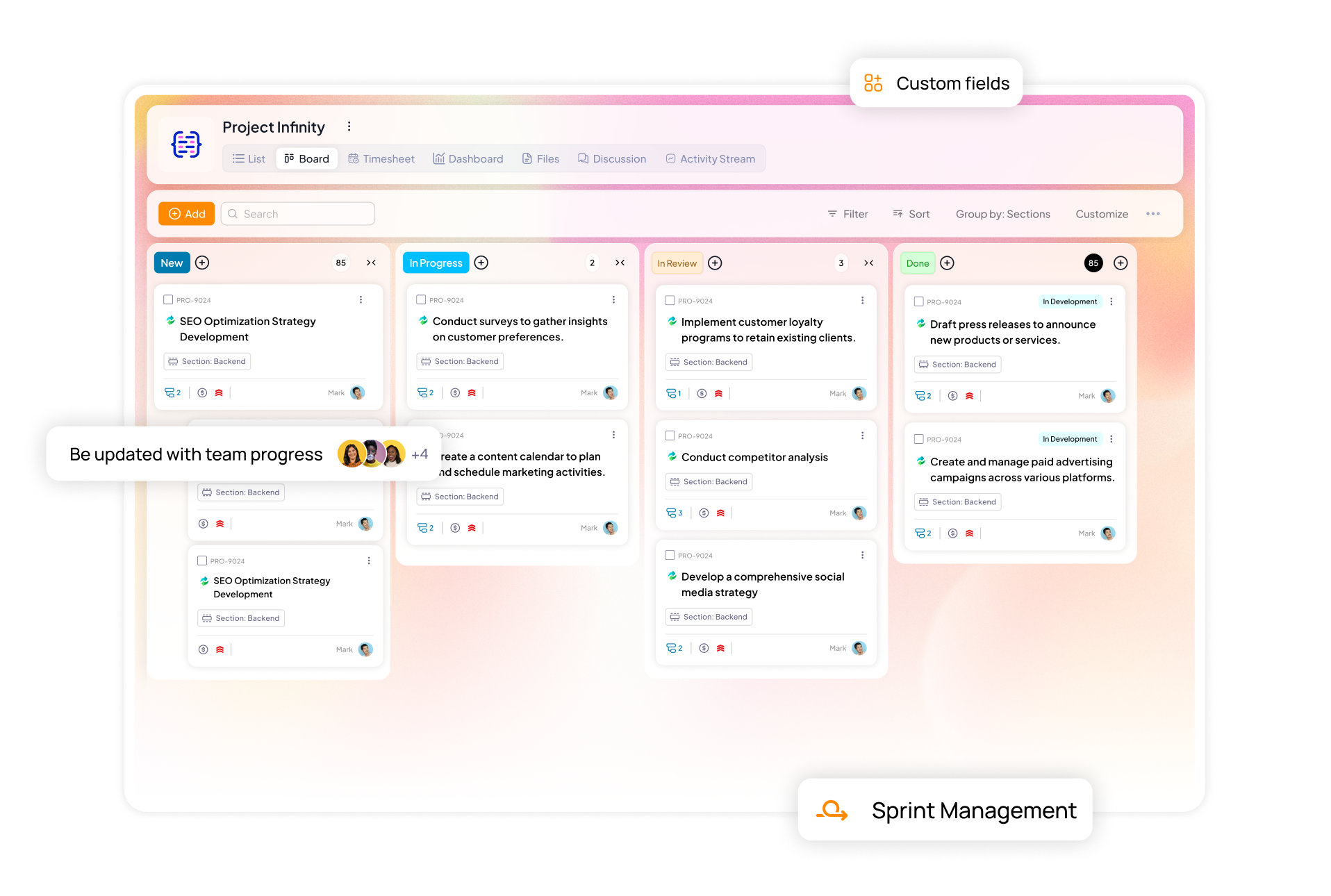You had the perfect brief. The ideas were bold. And your team? It’s just brilliant. Everyone was hyped to launch the next big campaign.
But somewhere between the kickoff call and the final asset, things cracked. Timelines blurred, and the feedback looped without an end in sight.
Here’s the hard truth: most marketing projects don’t fail because of bad ideas. Instead, they fail due to bad execution. Marketing project management is deceptively difficult. Creative work moves fast, but the chaos moves faster.
In this article, you’ll find the real reasons why marketing teams struggle with project management. And more importantly, what it actually takes to fix it.
Why is project management for marketing teams important?
Let’s first throw the common misconception out the window.
Project management isn’t just for product teams. It is important for marketing teams, too. In fact, it’s the difference between a campaign that lands and one that limps.
Demand Metric research shows that only 27% of marketers report being very happy with how their teams manage projects. The consequences? Organizations are losing $109 million for every $1 billion invested in projects due to poor project performance.
Here are some common reasons for using project management for marketing teams.
-
To plan multi-channel campaigns
Detailed and structured project management lays the foundation for success. A simple product launch might involve email, paid ads, social media, influencer partnerships, landing pages, blog posts, and a webinar—all with different deadlines and contributors.
Marketing team project management helps plan and avoid any backlog of activities and tasks when there are multiple moving parts.
-
Need for collaboration
Marketing projects require complete team collaboration. The sales team wants a deck. The product team wants the messaging aligned. The design team needs time to deliver assets.
Without a shared system for collaboration, it’s easy to get trapped in silos and miss the bigger picture.
That’s where project management helps marketing teams with a central space to align their efforts. With a proper system, they can delegate tasks and reduce the back-and-forth. When everyone works off the same playbook, execution becomes faster and way less stressful.
-
To prove marketing ROI
CMOs are under pressure to show outcomes. If your team can’t tie execution to performance, budget cuts are around the corner. That means tracking timelines and outcomes, all in one place.
Successful project management helps marketing teams track timelines and deliverables in one place. Proper structure helps measure the real impact of each campaign. Without it, teams often face difficulties in project management, making it harder to prove ROI than it should be.
For all these reasons, marketing teams need a structured workflow to avoid wasted budgets and missed deadlines.
Common challenges of marketing team project management (with actionable fixes)
Every department hits snags when it comes to project management challenges. But marketing’s fast-paced, creative nature adds its own twists. Below is a list of the five most frequent challenges in project management for marketing teams, and exactly how to overcome each one.
-
Scope creep and vague briefs
Marketing projects often expand beyond their original intent as new requests sneak in, and priorities shift midstream. Now, suddenly, your campaign’s scope has tripled without extra time or budget.
According to the Institute of Project Management, this happens because of undefined scope and inconsistent requirement gathering. These lead to wasted effort and budget overruns unless checked by a documented project charter and Work Breakdown Structure (WBS).
How to fix it:
- Write a clear scope with in-scope and out-of-scope deliverables
- Use a change request checklist for every new ask, making sure to approve it (or park it)
-
Complex feedback loops
Ever had three people send edits on three different versions of the same social post? Or chased feedback for days, only to get it after the post went live?
Marketing feedback is often subjective and unstructured. Everyone has opinions, but no clear review workflow. Marketing thrives on timely feedback and approvals from multiple stakeholders, including creative teams, legal teams, and senior leadership. And if that lags, teams miss critical deadlines.

How to fix it:
- Set clear stages like Draft → Internal Review → Client Review → Final.
- Use approval workflow to assign each stage, set timelines, and lock versions after each round.
- Tag each reviewer in the project management software like 5day.io , so no more chasing “who saw this?”
Pro tip: Add a 24-hour review rule. So, if there is no feedback in 24 hours, move forward. This can save weeks every quarter.
-
Overloaded tool stack
Designers in Figma, writers in Docs, planners in Trello, and nobody knows where to look first. Most project management tools are built for software teams. Marketers bend multiple tools into something that sort of works, but mostly just creates silos.
The most efficient teams track everything from campaign kickoff to performance metrics in one workspace. If you’re switching tools 20 times a day, that’s not agility, but ends in exhaustion.
How to fix it:
- Consolidate everything into a marketing project friendly platform
- Keep your briefs, timelines, feedback, approvals, and performance in one place using 5day.io
- Host core deliverables and workflows in 5day.io, then embed or link out to specialized tools like Google Docs.
-
Resource overcommitment
Your designer is on three campaigns. Your content lead is writing emails, case studies, and social media content. Deadlines keep moving, but no one’s adjusting workloads.
Marketing doesn’t always factor capacity into planning. And if you don’t track bandwidth, everyone ends up overbooked.

How to fix it:
- Tag every task in 5day.io with estimated hours and assigned owner
- Block 20% of each person’s time for unplanned tasks or urgent pivots
-
Budgeting blind spots
You’ve scoped out a killer campaign, videos, influencers, landing pages, PR, and paid ads. But halfway through, the budgets already stretched thin. You start slashing deliverables or absorbing unpaid overtime. Neither ends well.
According to the PMI’s Pulse of the Profession (2022 report), nearly 50% of failed projects cite budget overruns as a key cause. Creative teams love thinking big (and that’s good). But without a budgeting structure during planning, ambition can quietly run over resource constraints. That’s why better planning beats last-minute patchwork, every time.
How to fix it:
- Use cost-based estimates to assign an estimated cost per task or asset
- Compare planned spend with actual spending, so you course-correct early, not after the budget’s blown
- Collaborate with finance at kickoff to know what you’re working with, and build with intention
-
Post-campaign analysis gaps
Campaigns launch, but data lives in separate analytics dashboards as no one connects the dots. No one asked important questions: What worked? What flopped? And they move on to the next one.
Marketing teams often are busy, so they think retrospectives are optional. Metrics live in separate spreadsheets, and lessons don’t carry forward.
How to fix it:
- Schedule a 30-minute review two weeks post-launch. Focus on what worked, what didn’t, and the next steps.
- Use Custom Fields in 5day.io to log CPL, CTR, and revenue next to each campaign milestone—so reporting is part of the project, not an afterthought.
- Ditch spreadsheets for capable project management tools like 5day.io to avoid manual updates and oversight gaps.
-
Inadequate risk planning
Most marketing plans look great on paper. But real-world campaigns have real-world interruptions. For instance, a tool can break, or a platform change can destroy performance overnight. If your only strategy is to “hope it doesn’t happen,” you’re already behind.
Marketing teams sprint from one deadline to the next. So, they often ignore risk planning, and it won’t stop things from going wrong.
How to fix it:
- Brainstorm potential risks before every major campaign like tech dependencies or budget cuts
- Schedule a meeting early in the planning phase to be prepared
- Prepare a detailed plan for each risk, noting the likelihood, impact, and contingency plan
Tackle project management challenges for marketing teams with 5day.io

Marketing teams often try to drive growth in a space full of competing priorities and subjective creative paths. The right marketing team project management approach doesn’t stifle creativity, rather, it channels it.
That’s where 5day.io for marketing fits in—not as “yet another tool,” but as a shared workspace built around how marketing actually works. Here’s how to tackle project management challenges for marketing teams.
- Start every project with a clear brief and track every proejct milestone Standardize your process with templates and approval stages
- Keep briefs, tasks, and assets in one place with easy links to OneDrive and Google Docs in 5day.io
- Track deliverable and timeline performance , then learn and iterate
- Track actual vs. planned costs as you go, so no manual reconciliation needed
- Log campaign metrics right inside the task view and bring performance data into your retrospectives
- Create a pre-launch checklist with risk flags, fallback actions, and owner accountability
With a structure that supports and not restrict your creative flow, you’ll deliver more and learn faster.
So, if you’re ready to simplify your campaigns without slowing them down, try 5day.io now. It is completely free for 30 days.
Start today with 5day.io for free
Frequently Asked Questions
Q.1. How to identify a challenge in marketing project management?
A good way to spot a marketing project management problem is to look for patterns. For example. If the deadlines are slipping, or if the teams are unclear on project priorities. These are the signs that something is wrong beneath the surface.
You can pose the following simple but specific questions during campaign planning or retrospectives.
- Was the team clear on who was doing what?
- Did we track the actual campaign outcomes?
- What caused the delays in our last project?
Note if the answers were clear or not. Most marketing project challenges don’t show up all at once. They crop up in little inefficiencies that inflate over time. Catching them early gives you room to fix them before they become blockers.
Q.2. How can marketing teams build project management skills internally?
Start by introducing foundational PM concepts. For example, explain what work breakdown structures, risk logs, and stakeholder mapping are through short workshops or online courses.
Encourage team members to earn a basic certification (like Google’s Project Management Certificate) and embed peer-led “lunch & learn” sessions where marketers share their PM tips and templates.
Q.3. How do cross-functional teams manage dependencies in complex marketing programs?
Use a Dependency Matrix to map which tasks (creative, technical, legal review) rely on others. Then, establish “handoff ceremonies” covering short alignment meetings at key project milestones to confirm prerequisites are met before moving to the next stage. Embedding these into your project calendar ensures you never miss a crucial approval and avoid bottlenecks in your launch timeline.






